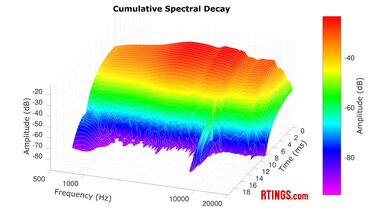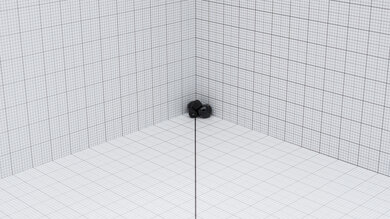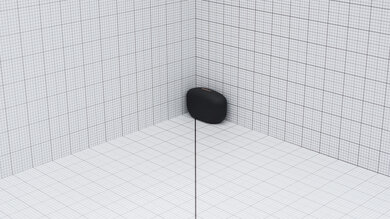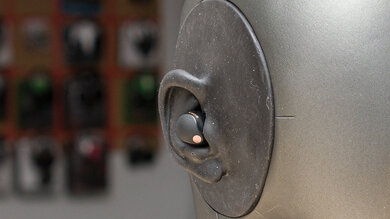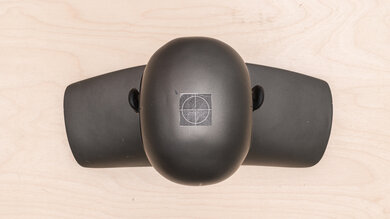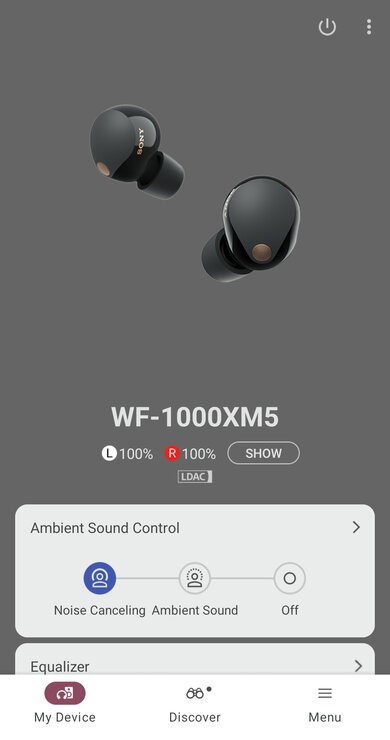The Sony WF-1000XM5 Truly Wireless are the next generation of the Sony WF-1000XM4 Truly Wireless. A few changes in design and performance have provided an elevated experience compared to their predecessor. Physically, these premium buds have a smaller, more rounded shape and use memory foam ear tips, allowing them to block out a lot of background noise passively. Not everyone will like how they feel and fit, especially if you have small ear canals. Their noise cancelling (ANC) system has also improved, and there's been some sound re-tuning to help balance out the predecessor's recessed treble.
Our Verdict
The Sony WF-1000XM5 are great for sports and fitness. Although they don't have stability fins, these lightweight buds won't fall out during tough reps at the gym. They're also well-built and are IPX4 certified, so they can survive splashes of water without taking damage. Their continuous battery life will last through most extended workouts, too. That said, their memory foam ear tips can cause fatigue if you don't get a good fit or have small ear canals.
-
Excellent overall noise isolation.
-
IPX4 certified for water resistance.
-
Well-built and stable fit.
-
Foam eartips may be uncomfortable for some.
The Sony WF-1000XM5 are great for travel. These lightweight buds are easy to take with you on the go. Their ANC system can block out the low rumbles of bus engines well, and with the ANC on, they last over eight hours continuously. There are a couple of additional charges in the case if you run out of juice on a trans-continental flight. That said, not everyone will find their memory foam ear tips comfortable due to the pressure they apply on your ear canal.
-
Excellent overall noise isolation.
-
Well-built and stable fit.
-
Foam eartips may be uncomfortable for some.
The Sony WF-1000XM5 are good for office work. They're equipped with an ANC system that can easily block out background noise like chatty coworkers and the hum of computer fans. They also support multi-device pairing, allowing you to stay connected to your PC and smartphone simultaneously. If you like to listen to audio at high volumes, others around you won't hear it. However, while their memory foam ear tips will form a firm seal once properly fitted, some people may find that the tips put too much pressure on their ear canal, which can be uncomfortable.
-
Excellent overall noise isolation.
-
Well-built and stable fit.
-
Supports multi-device pairing.
-
Mic has poor recording quality.
-
Foam eartips may be uncomfortable for some.
The Sony WF-1000XM5 are Bluetooth-only buds with high latency on PCs, so you'll experience noticeable audio/visual desync.
The Sony WF-1000XM5 are truly wireless buds; you can't use them wired.
The Sony WF-1000XM5 have very good audio reproduction accuracy. Their frequency response deviates minimally from their warm sound profile. Group delay is well managed, leading to tight bass and transparent treble. While there is some frequency and phase response mismatch in the high-treble, they're on the edge of the hearing range and are unlikely to be audible. Aside from the higher frequency deviations, the L/R drivers are well-matched, resulting in a gapless stereo image with accurate positional cues. While they produce some measured distortion at high volumes in the treble, most people won't notice an issue at typical listening levels. As in-ear headphones, they bypass the pinna and won't improve immersion through interactions with your outer ear.
The Sony WF-1000XM5 are amazing for noise isolation. Their ANC system supplements the solid passive isolation of their ear tips, resulting in mitigation of noises from rumbling engines to whistling passersby. They also don't leak much audio, barely exceeding the noise floor of a quiet room.
The Sony WF-1000XM5 have a mediocre microphone. Recordings will lack depth when capturing your voice, while loud, sustained noises overwhelm the mics' onboard noise handling, making you unintelligible.
The Sony WF-1000XM5's frequency response consistency is great. If you take the time to find the ear tips that provide you the best in-ear seal, the headphones' behavior will closely match our frequency response measurements.
- 8.1 Sports And Fitness
- 8.2 Travel
- 7.6 Office Work
- 5.6 Wireless Gaming (In Development)
- 5.5 Wired Gaming (In Development)
Performance Usages
- 7.9 Audio Reproduction Accuracy
- 8.6 Noise Isolation
- 6.1 Microphone (In Development)
- 8.1 Frequency Response Consistency
Changelog
-
Updated Apr 29, 2025:
We've updated the review to mention the Technics EAH-AZ100 in the Harmonic Distortion box.
-
Updated Apr 25, 2025:
This review has been updated to Test Bench 2.0, which adds the following tests: Stereo Mismatch, Group Delay, Cumulative Spectral Decay, PRTF, Harmonic Distortion, and Electrical Aspects. We've added new performance usages and updated the text throughout the Sound tests and side-by-sides.
- Updated Apr 25, 2025: We've converted this review to Test Bench 2.0, which updates our sound tests and adds performance usages. You can read more about this in our changelog.
-
Updated Nov 12, 2024:
The Bluetooth Connection section of this review now mentions our Best Wireless Earbuds For Android article.
-
Updated Oct 30, 2024:
We updated the App Support and Bluetooth Connection boxes with information about Sony's 4.0.2 firmware update for these buds. The update includes three new features: Find My Device, Auto Switch, and Google Fast Pair support.
Differences Between Sizes And Variants
The Sony WF1000XM5 come in a couple of color variants: 'Black' and 'Silver'. We tested the Black variant; you can see our model's label here. If you encounter another variant of these headphones, please let us know in the forums, and we'll update our review.
Compared To Other Headphones
The Sony WF-1000XM5 are the successor of the Sony WF-1000XM4 Truly Wireless, and there have been a few improvements to their design and performance worthy of their premium price tag. Their noise isolation performance has improved greatly, putting them on par with heavy hitters like the Bose QuietComfort Earbuds II Truly Wireless. A large reason behind their capabilities is their form-fitting memory foam ear tips rather than their ANC, as this allows them to easily and passively isolate you from a significant amount of sound. Their sound has also balanced out a bit, with a bit more treble, lessening the overall dark sound of their predecessor.
Check out our picks for the best noise cancelling earbuds, the best wireless Bluetooth earbuds, and the best Sony headphones.
The Bose QuietComfort Ultra Headphones Wireless and the Sony WF-1000XM5 are flagship options from their respective manufacturers that cater to similar usages despite their different designs. The Bose are over-ears, while the Sony are buds with an in-ear fit. You might immediately gravitate towards one design over another, and both are comfortable in their own right, though the Bose's thick padding is great for long-haul flights. That said, the Sony headphones have the edge regarding portability and stability, and their lightweight design is an advantage for sports and fitness. Interestingly, they have somewhat comparable sound profiles: both are warm-sounding, with elevated bass and smooth highs. The Sony deliver audio more consistently, though, and have better-matched drivers. Otherwise, two further differentiating factors are ANC and battery life. The Bose have the edge in both regards, with a superior noise isolation performance and a longer continuous (and total) battery life. The Bose even has a better mic that renders your voice more clearly for calls.
The Bose QuietComfort Ultra Earbuds Truly Wireless and the Sony WF-1000XM5 Truly Wireless are both premium wireless in-ears with similar strengths. Choosing between them is a matter of personal preference. Both buds are great for commuting and travel as they have a comfortable fit, decent battery life, and excellent overall ANC performance. You can also tweak the sound profiles of both buds to your liking via their EQ. However, the Sony headphones are slightly better for those who prioritize taking phone calls due to their superior noise-handling performance.
The Technics EAH-AZ100 and the Sony WF-1000XM5 Truly Wireless are similar earbuds. While the Sony are less expensive, there are some performance tradeoffs: their battery life is a shorter 8.75 hours compared to the Technics' 12.2 hours, their virtual surround feature requires specific applications (like Sony's 360 Reality Audio Live) compared to the more ubiquitous Dolby Atmos required by the Technics, and they have less customizable controls. Both earbuds have comparable, top-tier ANC systems that handily tackle noise from airplane cabins to busy streets.
The Sennheiser MOMENTUM True Wireless 4 and Sony WF-1000XM5 Truly Wireless are both very competitive premium earbuds. Both are neck and neck regarding their noise isolation, with the Sennheiser filtering a bit more midrange-y noise and the Sony blocking a bit more bright trebly noise. Both earbuds support quality Bluetooth codecs, with the Sennheiser using aptX Adaptive (Low Latency, High Quality, and aptX HD). However, if you care about virtual surround sound, only the Sony headphones support the feature. The Sony are also slightly less chunky and use memory foam ear tips to isolate and secure their fit. They support LDAC Bluetooth codec, and their wireless range is greater.
The Sony WF-1000XM5 Truly Wireless are the next generation of the Sony WF-1000XM4 Truly Wireless. Some upgrades have been added to the XM5, like a new design that makes them more comfortable in-ear and a tweak to their sound profile to rebalance their treble. Their noise isolation performance is significantly better, too, but a large part is due to their memory foam ear tip design, which forms a tight seal in your ear and passively blocks a lot of sound. Overall, they're an improvement from their predecessor and are worth considering if you liked the XM4.
Whether you prefer the Sony WF-1000XM5 Truly Wireless over the Samsung Galaxy Buds3 Pro may largely depend on your device's ecosystem. Both have warm sound profiles by default with in-app EQ. The Sony work the same with Android and iOS devices and have a longer battery life. They have multi-device pairing with up to two devices, too. On the other hand, if you're a Samsung user, you can seamlessly switch between different devices on the same Samsung account. Their mic also sounds more natural, and their IP57 rating outdoes the Sony's IPX4 rating. Finally, the Samsung also boast slightly better noise isolation overall, even if the Sony block bright sounds better.
If you care about customizability, you'll want to check out the Sony WF-1000XM5 Truly Wireless over the Apple AirPods Pro (2nd generation). While the Apple earbuds have better ANC, the Sony headphones' companion app offers a graphic EQ and presets. The buds also have wider support for multi-device pairing so you can stay connected to your PC and smartphone simultaneously. However, the Apple headphones are better built and have an H2 chip for seamless pairing with Apple devices.
The Jabra Elite 10 Gen 2 and the Sony WF-1000XM5 Truly Wireless are both premium earbuds with virtual surround sound and EQ to suit your taste. The noise isolation is close between them, but the Jabra have a less invasive in-ear fit than the Sony, which some people might find more comfortable than the deep-fitting memory foam tips for the Sony. The Jabra's mic sounds better and handles background noise better than the Sony if you take a lot of calls. However, the Sony headphones' continuous battery life outlasts the Jabra's continuous battery life and the Sony support LDAC. Jabra's unique 'smart case' lets you connect your earbuds to wired sound sources.
The Technics EAH-AZ80 and the Sony WF-1000XM5 Truly Wireless are both premium in-ears with noise cancelling technology (ANC). They're both excellent all-around performers with similar feature sets and slight differences, so you could opt for one over the other depending on your preferences. They both have a similar warm sound profile that you can tweak via the in-app EQ and presets. They also have comparable battery life performance and feature LDAC support. While the Technics are better built, the Sony have a slight edge in the noise isolation department, thanks to their excellent passively isolating foam tips. Meanwhile, the Technics have three-way Bluetooth multi-point connectivity, which can be useful if you bounce between a work phone, personal phone, and laptop.
The Sony WF-1000XM5 Truly Wireless are better earbuds than the Beats Fit Pro True Wireless. The Sony have a more comfortable fit, and you can fine-tune their sound thanks to their companion app's graphic EQ and presets. They also have a better overall battery performance and support multi-device pairing. If you want to listen to higher-resolution audio, they even support LDAC, Sony's proprietary high-res audio codec. Their ANC can also block out more ambient sound, which is handy for commutes or noisy offices. However, you may still prefer the Beats if you want colorful buds to match your aesthetic.
You may prefer either the Sony WF-1000XM5 Truly Wireless or the Denon PerL Pro True Wireless, depending on what you're planning to use your earbuds for. The Sony are better for commuting and casual use when you're out and about, thanks to their longer battery life and better ANC performance. You can also set their ANC to different modes to suit the situation. They support head gesture controls, which allow you to answer and end calls without using your hands. However, the Denon headphones are a better choice if you're mainly concerned about audio quality. Unlike the Sony, they can stream aptX Lossless audio. You can also use their app to create a personalized EQ based on a hearing test.
The Sony WF-1000XM5 Truly Wireless and the Nothing Ear are feature-packed with high-quality Bluetooth codecs and different approaches when it comes to performance. The Sony use touch controls with good sensitivity, while the pinch controls on the Nothing are somewhat divisive. Thanks to the included foam ear tips, the Sony have more powerful noise isolation overall. Their continuous battery life is longer too, at 8.75 hours, compared to the Nothing's 7.5 hours, but with additional charges stored in the case, the Nothing outdoes the Sony on total battery capacity. Only the Sony includes a spatial audio option, but otherwise, the Nothing's EQ is more nuanced than the Sony's, and even includes an adjustable Q-factor. The Nothing have a higher IP rating against dust and water. However,. some things are taste-based, like the tuning, and the Nothing's less invasive feeling fit, compared to the Sony's deep in-ear fit.
The Sony WF-1000XM5 Truly Wireless are somewhat better in-ears than the Sony LinkBuds S Truly Wireless. While both buds are comfortable and well-built, the WF-1000XM5 can block out more ambient noise, although this is largely due to their memory foam ear tips creating a tight seal within your ear. Their battery performance is better, too. That said, the LinkBuds S' mic has a better recording quality.
The Sony WF-1000XM5 Truly Wireless are similarly performing earbuds to the Google Pixel Buds Pro 2 in some regards such as noise isolation, but the Sony are also better stereo matched with tighter group delay. The Sony are bulkier and weigh more, but their foam ear tips help them passively mitigate more noise in the treble range, like squeaky brakes. On the other hand, the Google support newer features like 'Audio Switch,' which allows seamless switching of audio playback sources when logged into the same Google account, and 'Find My Device' for both the case and earbuds.
The Sony WF-1000XM5 Truly Wireless and Jabra Elite 10 are both top-of-the-line headphones. In many ways, they offer similar overall performance with customizable sound. You can even expect high levels of noise isolation from both buds, though the Jabra have the slight edge in this regard. The Sony support LDAC, which is great if you like to stream hi-res audio content.
Despite having very different designs, both the Sony WH-1000XM5 Wireless and the Sony WF-1000XM5 Truly Wireless feature class-leading noise cancellation technology that excels in blocking out ambient noise. However, the WH-1000XM5 can mitigate more sound across the frequency spectrum. They also have a longer battery life and better mic performance. You can use them with a wired connection for a low-latency performance that's better suited to gaming. That said, the WF-1000XM5 are a better choice if you value portability and stability and don't mind an in-ear fit. For this reason, they're better for commuting and fitness use.
The Sony WF-1000XM5 Truly Wireless are better by most measures than the Sony WF-C700N Truly Wireless. The WF-1000XM5's noise cancelling and isolation performance is in a different class and handily reduces plane and bus engines well, alongside chatter and clinking glasses. They use touch controls instead and are a bit chunkier, although not large. Of the two models, only the WF-1000XM5 supports the LDAC codec for higher-quality audio. Both have the same IPX4 rating and use the same app, although the WF-1000XM5 Truly Wireless have an expanded feature set for customizing controls. While both have similar continuous battery lives, the WF-1000XM5 case stores an extra full charge. Both are comfortable to wear and stable.
The Bose QuietComfort Earbuds II Truly Wireless and the Sony WF-1000XM5 Truly Wireless are both great pairs of in-ear headphones. The Bose are more comfortable, and their ANC can block out more background noise in the bass range, where you'll find the rumble of bus engines. In comparison, the Sony headphones have more robust sound customization features. They have longer battery life and support multi-device pairing and LDAC, which is Sony's proprietary codec for hi-res audio streaming via Bluetooth. They can also block out significantly more ambient sound in the mid to treble ranges, where you'll find noise like ambient chatter and the hum of an AC unit, respectively.
The Jabra Elite 8 Active Gen 2 are a better choice for most use cases than the Sony WF-1000XM5 Truly Wireless. Both buds offer similar levels of comfort and stability, though the Jabra are better built with an IP68 rating against dust and water damage. The Jabra headphones have a 'smart case' that allows you to connect devices via a wired USB-C or AUX connection. While the Sony headphones are well-known for their excellent noise isolation performance and passively isolating tips, the Jabra buds offer even more attenuation, and their silicone tips also provide a solid seal. The Jabra have a better-quality mic with better noise handling. That said, the Sony have access to a Hi-Res audio through their proprietary LDAC codec.
The Sony WF-1000XM5 Truly Wireless are premium in-ears that are better than the more mid-range Beats Studio Buds + True Wireless. The Sony have a longer battery life, multi-device pairing so you can connect to two devices simultaneously, and a companion app with EQ and presets to customize your sound. The Beats are rated just as well against water splashes, and their noise isolation is almost as good as the Sony's.
The Sony WF-1000XM5 Truly Wireless are better in-ears than the Sennheiser MOMENTUM True Wireless 3. The Sony are more comfortable and have better noise isolation performance, largely due to their memory foam ear tips, which help form an airtight seal. They also support LDAC, which is a Hi-Res codec. However, the Sennheiser are better built and support multi-device pairing with up to three devices simultaneously, one more than the Sony. Both headphones have customizable sound profiles, thanks to their companion apps' graphic EQs, though.
The Sony WF-1000XM5 Truly Wireless are better than the Bose QuietComfort Earbuds Truly Wireless. They offer a longer continuous battery life, a more comfortable fit for most, and a better ANC performance. They also support multi-device pairing and the LDAC codec for streaming high-res audio.
The Sony WF-1000XM5 Truly Wireless are the manufacturer's premium earbud offering, with a few features that give them the edge over the Apple AirPods 4 with Active Noise Cancellation. They have an in-ear fit, with different ear tip sizes to choose from, that forms a comfortable, stable fit. That said, many users will gravitate towards the Apple's one-size-fits-all design, which is comfortable without going into your ear canal. However, this difference in approach means that the Sony outperform the Apple when it comes to noise isolation due to the tighter seal formed with their memory foam tips. The Sony also have a longer continuous battery life. While the Apple have a better performing mic, a lot of their features are available for iOS users only, so Android users won't have the same experience.
Video
Test Results
Sony has re-tuned this generation of the WF-1000XM lineup, flattening the upper range of their predecessor's sound a bit. The Sony WF-1000XM5's sound profile is warm with the ANC on. They're well-suited for various genres out of the box, but if you prefer a different sound, their companion app offers a graphic EQ and presets so you can fine-tune their sound to your liking. You can also see a comparison of all the EQ presets here. There's also a 'Find Your Equalizer' feature, which generates an EQ based on your unique hearing preferences. When using this feature, your personal EQ will replace the 'Custom 2' preset.
Although we expect most people to use these headphones with the ANC on, it's worth noting that there's a minor difference in sound profile when the ANC is off compared to on. With ANC off, you get more thumpy low bass but slightly weaker vocals and instruments, which are nudged to the back of the mix. You won't experience a difference in frequency response if you're using LDAC or SBC codec either.
The Sony WF-1000XM5's frequency response consistency is great. Their foam tips maintain the in-ear seal across the frequency range. While the consistency plots show deviations in the high-treble, they're due to the difference in frequency response between both drivers rather than the seal being compromised, as the normalized value used to calculate consistency for in-ears is the averaged response of both drivers.
These buds do a great job of following our target curve in the bass range. The response is overemphasized and slightly tilted, so mixes have more warmth and boom than thump and rumble. In songs like Feeling Good by Nina Simone, the brass instruments following the refrain are punchy and weighty. If you want a sound signature that leans more into the low-bass out of the box, the Sennheiser MOMENTUM True Wireless 4 offer a tilted bass response that you can easily tweak to taste.
These buds' target compliance in the mid-range is excellent. While their frequency response follows our target curve overall, minor overemphasis creeps in from the bass range into the low-mid, which can result in a slightly cluttered sound. That said, the mid- and high-mid is quite flat, resulting in adequate detail in lead vocals and instruments.
They also have outstanding treble target compliance. Compared to that of their predecessor, the Sony WF-1000XM4 Truly Wireless, their response in this range is much more flat and with less roll-off relative to our curve. Although slightly underemphasized, vocals and instruments are detailed, while the sibilants, like cymbals, sound rounded without becoming completely dulled and lispy.
The Sony WF-1000XM5's peaks and dips performance is great. For the most part, these buds' frequency response make few deviations from their warm sound profile. However, the most significant peaks and dips are in the treble range. Minor fluctuations in the treble can cause sibilants to alternate from slightly dull to bright, while larger deviations in the high-treble can cause the upper harmonics of instruments and vocals to sound hissy or closed off depending on their pitch. That said, this can be harder to hear, especially as we lose sensitivity to this range over time.
These headphones' L/R drivers are superbly well-matched. Overall, the frequency, phase, and amplitude mismatch between the drivers are below audible levels, meaning the headphones accurately render sound sources in the stereo image without gaps or leaning in one direction. While there are minor matching issues in the high treble of both phase and frequency response, we lose sensitivity in this range over time, and you're unlikely to notice these deviations during everyday listening. Additionally, driver matching is an indicator of quality control, so performance varies from unit to unit.
These headphones have excellent group delay performance. It remains below audible levels throughout the measured frequency spectrum, resulting in tight bass, defined transients, and transparent treble.
The Sony WF-1000XM5 Truly Wireless bypass your outer ear by design, which limits their capability to create an immersive sound through pinna interaction.
These headphones have okay harmonic distortion performance. At regular listening volumes, vocals and instruments are accurately and clearly reproduced. In the bass range, even at high levels shown on our graphs, perceivable harmonic distortion is minimal due to our lack of sensitivity at lower frequencies. While there is more measured harmonic distortion in the treble, you likely won't be listening to anything this loud, as high levels at this range can be harmful to your hearing. If this is still a dealbreaker for you, consider the Technics EAH-AZ100, which have less harmonic distortion across the board.
These earbuds aren't wired, so you won't need an amp to drive them.
These headphones are compatible with Sony's 360 Reality Audio feature. You can only access this feature via the companion app, and it can analyze your ear shape to create a custom sound profile. It also optimizes compatible audio through supported apps like 360 Reality Audio Live and TIDAL to give you a more immersive and 3D audio experience. However, you may also need a subscription to these services to take advantage of this feature.
These are the settings used to test the Sony WF-1000XM5 Earbuds; our results are only valid when used in this configuration.
The Sony WF-1000XM5 have a rounded teardrop shape that looks much smoother in design than the Sony WF-1000XM4 Truly Wireless. The previous generation have copper accents that protrude outward for their mics, but this model uses flat copper grilles that are flush with the touch-sensitive surface instead. They come in two color variants: 'Black' and 'Silver'.
The Sony WF-1000XM5 Earbuds have a comfortable fit. They have a more ergonomic fit than their predecessor since the bud's shape puts less overall pressure on the lower part of your inner ear. They're also quite lightweight. Even though the buds aren't as bulky, the charging elements and surrounding plastic can still feel sharp and irritating against your inner ear, depending on your ear shape.
They come with four pairs of memory foam ear tips, ranging from extra small to large. This material is comfortable since they're more malleable and form-fitting and less stiff than those included with the Sony WF-1000XM4 Truly Wireless. This material choice also helps improve the seal of the buds in your ears as it can mold to the shape of your ear canal for a more flush fit. That said, the memory foam will degrade over time and eventually needs to be replaced to maintain similar noise isolation levels. Some users have also reported that the ear tips aren't very comfortable and put pressure on the ear canal. A few users have also suggested using completely different ear tips to get a better fit. If you have small ear canals, you may also have difficulty achieving a snug and stable fit, even with the smallest included tip size. However, even with these negatives, the XM5's updated design is more comfortable than their predecessor's.
These buds have good controls. Each bud has a touch-sensitive surface that provides beeps to let you know when you've registered a command. You can turn on voice prompts if you prefer, though, and you can also remap controls via the companion app to add features like 'Spotify Tap', which allows you to access Spotify, as well as head gesture recognition, so that moving your head allows you to answer and reject calls. When receiving a call, the buds will enter 'Capture Voice' mode, which allows you to monitor your voice while you talk. Unfortunately, it's easy to accidentally tap the controls if you need to adjust the buds' fit in your ear.
On the left earbud:
- Single tap: Cycles between ANC mode and Ambient Sound mode, which allows you to hear your surroundings without taking off the buds.
- Double tap: This is a quick access control, so you can remap particular commands to this control via the companion app.
- Triple tap: This is also a quick access control, which you can remap controls to this command via the companion app.
- Continuous tap: Lowers the volume.
- Tap and hold: Activates 'Quick Attention' as long as you have your finger on the earbud. Turns down your audio and allows you to hear ambient sound.
On the right earbud:
- Single tap: Plays and pauses audio.
- Double tap: Skips the track forward.
- Triple tap: Skips the track backward.
- Continuous tap: Raises the volume.
- Tap and hold: Uses or cancels voice assistant.
The carrying case is great. It feels less flimsy than the one with the Sony WF-1000XM4 Truly Wireless, as the material feels sturdier and more premium. There are magnets to hold the buds in place, too, and there's a pairing button on the back of the case. However, the plastic hinge feels like a weak point as it can degrade over time. We'll continue monitoring the case's durability as time passes, though.
These buds have a good build quality. They're mostly made of recycled plastic and come with memory foam ear tips. Overall, the buds feel dense and sturdy. That said, the ear tips will likely need replacing over time due to wear and tear as well as foam degradation, which can affect the sound quality and effectiveness of the ANC. There's no guarantee that they'll be available for purchase down the line, either. The buds are certified IPX4 for resistance, which protects against splashes of water. If you're looking for high-end earbuds with more protection from the elements, the Jabra Elite 10 are rated IP57 for dust and water resistance.
The Sony WF-1000XM5 have a stable fit, provided you get a good fit with the provided ear tips. Although they lack the stability fins that come with earbuds like the Bose QuietComfort Ultra Earbuds Truly Wireless, they won't move around or fall out with moderate or intense head movements, so you can wear them during workouts without sweating.
The Sony WF-1000XM5 have memory foam ear tips, which form a tight seal within your ear canal and help them passively block out a lot of background noise. They also have noise cancelling (ANC). We enabled Sony's 'Adaptive Sound Control' (ASC) feature, which allows the buds to automatically shift between ANC on and ambient sound mode depending on your environment and use. All four of its modes have the same ANC strength.
Using the ASC mode, 'Staying,' these buds block out bass range noise like the rumbly plane engines well, so you can enjoy your commute in peace. These buds stand out from other ANC headphones, including the Bose QuietComfort 45/QC45 Wireless, due to how well they isolate in the mid to treble range. However, a lot of the noise reduction is due to their form-fitting seal, and even when the ANC is on, the passive performance still does a slightly better job of reducing noise, particularly in the treble range. You may also prefer this if you work in a noisy office.
There's an adjustable transparency mode called 'Ambient Mode' in their companion app. With the Ambient Sound mode set to its strongest setting, it sounds less clear and natural-sounding than the Apple AirPods Pro (2nd generation). The Apple headphones' transparency mode makes background sounds crisp and clear. In contrast, the XM5 can muffle more background noise than the Apple. You'll hear sounds around you quite well, though.
After user feedback, we've looked into possible ANC changes after firmware 3.0.1. You can see the results comparing ANC on and off between 2.0.1 and 3.0.1, and that the overall isolation performance is very similar. The slight deviations in passes are largely due to the fit of the foam ear tips as they expand and contract in our test rig's ears and aren't because of a change in ANC performance.
When it comes to common scenarios, these buds can block out a great amount of sound. They can tackle rumbly plane cabins and busy streets so that you can travel in peace. They're also well-suited for reducing office noise like coworkers chatting. If you find the isolating memory foam ear tips uncomfortable, the Sennheiser MOMENTUM True Wireless 4 can accomplish similar amounts of noise reduction with silicone ear tips instead.
Wind noise is a bit different than other sounds as it directly interacts with the ANC microphones. This leads to loud and annoying noise as the ANC system is countering a sound that isn't reaching your ear. Unfortunately, the Sony WF-1000XM5 Truly Wireless struggle with wind noise. They also lack a wind reduction feature to help make this noise more manageable, so you'll want to avoid windy environments if it's too bothersome for you.
The Sony WF1000XM5 have an outstanding leakage performance. Audio bleed is concentrated mostly in the bass and treble ranges but very low overall. As a result, you can crank up your favorite tunes to max volume without disturbing others around you.
The integrated mic's recording quality is poor. Your voice is understandable and crisp but lacks a lot of depth. It doesn't sound as dull as the Sony WF-1000XM4 Truly Wireless.
The mic's noise handling performance is decent. Background noise is still present if you're talking, but it's hard to hear it clearly. Your voice will still be understandable if you're taking a call from a moderately noisy environment like a busy office or street.
The Sony WF-1000XM5 also have a windshield feature. However, wind noise can still be heard when using this feature during calls and even when you've turned the ANC on. Compared to the Sony WF-1000XM4 Truly Wireless and the Apple AirPods Pro (2nd generation), the XM5 have a slight edge in reducing wind noise, but it's negligible. The XM5 can block wind noise when the mic isn't picking up your voice, but if you're talking, the wind noise is audible and can distract from speech.
The Sony WF-1000XM5's battery performance is good. Sony advertises eight hours of continuous playback time with the ANC on, and we measured just over that. This is great if you want to use the buds throughout your day without having to recharge them, and it even beats out the battery life of premium buds like the Devialet Gemini II True Wireless, which last under five hours continuously. If you're worried about battery life, turning ANC off will give you up to 12 hours of playback time. Keep in mind that battery life varies depending on use, though. Additionally, some Sony WF-1000XM4 Truly Wireless owners have reported that the batteries in their buds drained rapidly and unevenly, resulting in one bud dying significantly faster. Unfortunately, we can't confirm whether this problem extends to the XM5 model. However, we'll monitor the issue, and if you've encountered it with your XM5 model, please let us know in the forums.
The carrying case supplies a couple of extra charges if needed, and the buds have an auto-off mode that you can turn on and off in their companion app. This feature helps conserve battery life if you forget to put them back in their case. If you take the buds out of your ear, they'll also automatically pause your audio and turn off the ANC.
These buds are compatible with the Sony | Headphones Connect app; you can see a video of how it works here. Some features aren't available on the Sony WF-1000XM4 Truly Wireless, like Ambient Sound Control, which allows the buds to automatically shift between ANC on and ambient sound mode depending on your environment and use. There are four actions: 'Walking,' 'Staying,' 'Running,' and 'Riding a Vehicle.' You can also adjust Ambient Sound between levels 1-20, with 1 being full transparency and 20 being full noise cancelling. Head gesture commands allow you to answer and reject calls by moving your head.
In addition to the features above, there are a few tried and true features like a graphic EQ and presets for tweaking the buds' sound to your liking and 360 Reality Audio, their virtual soundstage feature. You can also remap controls, adjust audio playback, update the firmware, adjust the mic's sidetone, and adjust the automatic power-off feature. If you're looking to adjust your Bluetooth performance, you can adjust the Bluetooth's connection quality and toggle DSEE Extreme on and off, which is an AI low-bitrate upscaling feature for audio.
With Firmware 4.0.2, Sony renamed the Sony | Headphones Connect app to Sony Sound Connect. This update also brought a few new features. First, a Find My Device feature for the earbuds. As long as one of the buds is connected to the case, activating this feature will help you locate your buds by playing a chime that gradually increases in volume. Second, an Auto Switch feature that lets you quickly change your audio output device between your headphones and Sony's LinkBud Speakers. When using this feature, if you're listening to audio via your compatible LinkBuds speaker and then remove your headphones from their case, the audio should automatically switch to playing back via your headphones. Finally, the buds now support Google Fast Pair, allowing for a streamlined pairing process with Android devices.
You can't use these headphones wired. However, they come with a USB-A to USB-C cable to recharge the case. You can always check out the Jabra Elite 8 Active Gen 2 if you need to connect devices via a wired connection, as their 'smart case' acts as a transmitter between the buds and wired input sources.
The Sony WF-1000XM5 have great Bluetooth connectivity. Unlike the Bose QuietComfort Earbuds II Truly Wireless, they support multi-device pairing, so you can stay connected to your smartphone and PC simultaneously. If you need to connect to more devices than this at the same time, it's worth considering the Technics EAH-AZ80 for their 3-way multipoint instead. Like the Sony buds, the Technics also support Google Fast Pair for quick pairing with your Android device. If you're an Android user, check out our article on the best wireless earbuds for Android.
In terms of codecs, they support LDAC, a hi-res audio codec that allows you to stream your favorite tunes over Bluetooth with better sound quality, AAC, the default codec used by Apple, which has better sound quality than SBC, and LE Audio, for low-power audio transmission. However, they don't support the aptX Lossless codec, unlike the Denon PerL Pro True Wireless. That said, these buds have high latency on PC, whether you're prioritizing latency or audio quality via their companion app, causing lip sync issues. That said, latency won't be an issue if you're only using the buds for streaming audio. Some apps and devices also compensate for latency.
The Sony WF-1000XM5 earbuds have full audio and mic compatibility when connected via Bluetooth to supported PCs. However, this is the only connection you can use.
These buds come with a hard carrying case that supplies three additional charges. It has a USB-C port for charging the case and supports Qi wireless charging.


